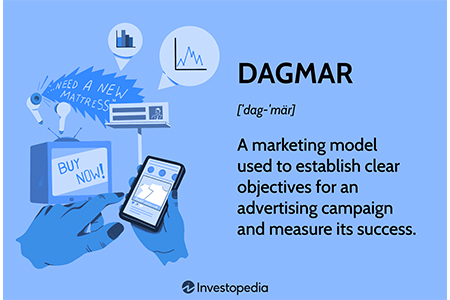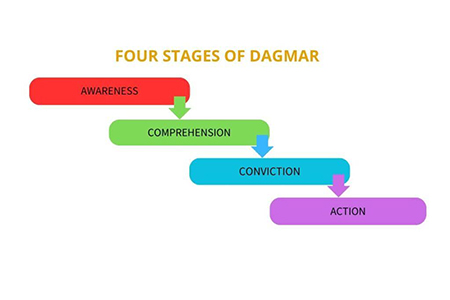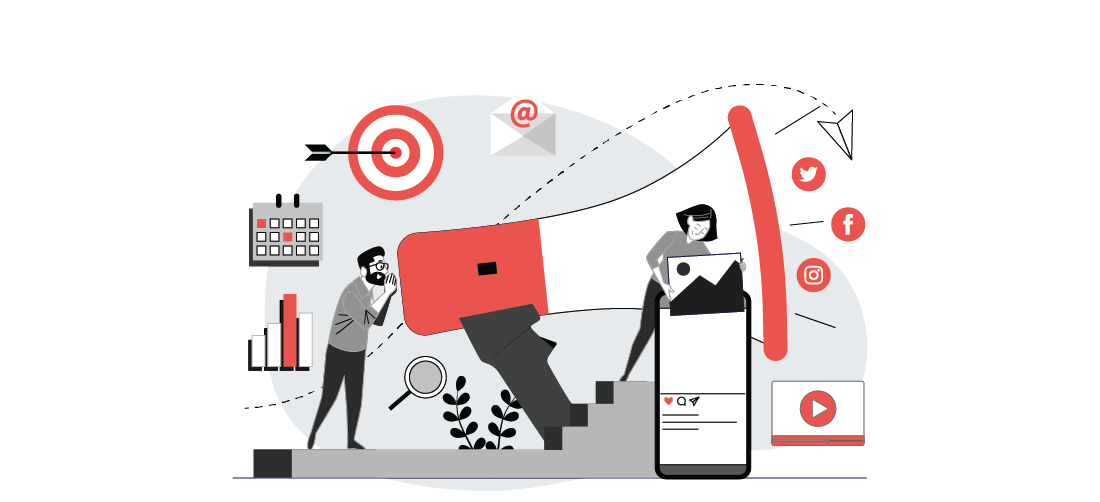What is DAGMAR: Model of Advertising?
Defining Advertising Objectives for Measured Advertising Responses
The DAGMAR advertising model is a strategic method used for establishing and quantifying advertising goals with accuracy. Its primary purpose is to establish clear, tangible goals that direct advertising efforts from initiation to completion. Practiced by most marketers, DAGMAR assists in assessing whether an ad is moving consumers along the decision-making path effectively, ensuring campaigns are not only creative but also goal-oriented and measurable.

Stages of DAGMAR: Model of Advertising

Awareness
The initial phase of the DAGMAR model, awareness, is concerned with making sure that your desired audience is aware of the fact that your brand exists. It forms the basis of more intensive engagement by capturing attention amidst the noise of the media. Good advertising at this phase is concerned with making the brand name or product very prominent and rememberable, laying the groundwork for more intelligent consumer interaction in the future.
Comprehension
Once attention is established, the DAGMAR model proceeds to comprehension, where the emphasis is on making the audience comprehend the worth of the brand, message, or product. It's communicating "what" and "why." This step ensures your message isn't merely observed but comprehended, with story-telling, clear messaging, and benefits-oriented content employed to instill meaningful interactions with prospective buyers.
Conviction
The conviction stage in DAGMAR focuses on developing a favorable attitude toward the brand. Here, the goal is to make the consumer feel confident about your product or service. Emotional appeals, testimonials, or rational benefits come into play, helping turn interest into preference. It’s not just about understanding now, it’s about believing that this brand is the right choice.
Action
In this last step, the DAGMAR model seeks to elicit a certain action, whether it is a purchase, registration, or inquiry. Action finalizes all that has been done before, converting awareness, understanding, and belief into a concrete outcome. An attractive call-to-action, convenience of access, and inducement can turn interest into actual buying behavior, effectively closing the advertising loop.

Features of DAGMAR: Model of Advertising
Goal-Oriented
The DAGMAR model is goal-driven by nature, taking advertisers through the process of defining specific results for every campaign. It steers clear of fuzzy creativity and makes sure that each communication effort is linked to an actionable business goal. Right from the beginning, it forces teams to ask, what are we actually trying to do, and how will we know we have succeeded?
Step-by-Step Process
DAGMAR provides an explicit, step-by-step plan for consumer involvement, awareness, understanding, belief, and action. This organized process reduces guesswork and assures each step flows from the previous. By progressing systematically through each phase, advertisers can create more intentional and effective campaigns that align with the consumer's choice process.
Measurable Outcomes
What makes DAGMAR stand out is its focus on quantifiable results. It demands that advertisers not only define success creatively but also numerically. Whether awareness metrics or conversion rates, DAGMAR demands that all goals be monitored and measured, so accountability and sustained improvement in advertising performance can be maintained.
Emphasis on Awareness to Action
DAGMAR stands out as it deals with the whole gamut of work, from awareness creation to action generation. This end-to-end focus guarantees that no phase is left behind. Every advertising action is coordinated to move the consumer slowly from being unaware to actually making a decision, rendering the model exhaustive and conversion-driven.
Pros of DAGMAR: Model of Advertising
Clear Objectives
One of the greatest strengths of the DAGMAR model is how well it allows for crystal-clear objectives. Rather than wishy washy aspirations, it invites advertisers to specify precisely what they desire people to think, feel, and do, offering each campaign clarity and direction from the start.
Focus on Communication
At its essence, DAGMAR improves the effectiveness of communication. It isn't merely concerned with reach; it wants to know if the message is reaching, being understood, and influencing action. It is thus a model first in communication, aiding brands to develop messages that speak meaningfully to their audience.
Better Planning
DAGMAR enhances planning through the segmentation of the advertising process into bite-sized steps. Since each step has its goal, brands are able to strategize resource allocation and customize creative efforts correspondingly. It diminishes waste and encourages a more strategic, effective campaign-building process.
Budget Justification
DAGMAR justifies advertising expenditure by linking spending directly to quantifiable results. Because objectives are well-defined and the outcome can be measured, stakeholders receive an open view of investment return. This facilitates defense of budget spending and future budget approval.
Behavior Tracking
By tracing the consumer path from awareness to action, DAGMAR allows brands to measure behavioral change throughout every stage. It allows identification of where audiences are falling off or converting, providing insight for optimization. This real-time measurement of behavior optimizes targeting and performance.
Realistic Goals
The DAGMAR model promotes the establishment of realistic and attainable objectives for every stage of the campaign. This practical approach keeps expectations tied to budget, market environment, and readiness of consumers, and hence minimizes the risk of overpromising and under-delivering.
Cons of DAGMAR: Model of Advertising
Time-Consuming
As useful as it is, DAGMAR can take some time. Identifying specific goals for each step, tracking performance, and adjusting strategies all take resources and time. It may be too slow for quick-turnaround campaigns or brands that want rapid visibility without strategic complexity.
Limited to Communication
DAGMAR tends to concentrate on communication objectives and not so much on more general marketing goals such as pricing or distribution. This makes it less applicable for brands wanting to consolidate their entire marketing mix under one model.
Measurement Challenges
Measurement of advancement at every step, particularly conviction, can be difficult. Though awareness and action are easier to measure, measurement of understanding and belief demands more subtle metrics, rendering implementation difficult for smaller brands without sophisticated tools.
Less Creative Focus
DAGMAR's focus on structure and measurement can at times limit creative freedom. Campaigns tend to become more rational messaging than emotionally rich storytelling, which may cut down the "wow" factor of groundbreaking brand campaigns.
Not Universal
DAGMAR is not suitable for all types of businesses or advertising contexts. It suits best for formal campaigns with measurable objectives. For test and brand-oriented campaigns, the model may be too inflexible or formalized.
Research Heavy
DAGMAR requires extensive market research and data analysis to be applied efficiently. Brands need to know their audience very well and possess the means to measure response at every step, which can be a strain on small businesses or new starts.
Choosing the Right Target Market for Applying DAGMAR For Advertising
The DAGMAR model succeeds best when used in clearly defined target markets. To use it, advertisers initially need to segment their audience by behaviors, needs, or demographics. Companies with the opportunity to work out of data-rich environments, such as retail, financial services, or technology, can use DAGMAR to develop customized campaigns for individual customer segments. Knowing your audience's decision path is essential, as the model relies on getting them to move through it step-by-step. The more defined the profile, the more actionable the goals so that DAGMAR produces measurable and sustainable outcomes.
DAGMAR: Model of Advertising in Modern Advertising
With the digital and data-driven advertising landscape today, the DAGMAR model is still quite applicable. With live analytics and user behavior monitoring, advertisers can now accurately quantify every step, awareness, understanding, conviction, and action. Be it a Google ad or a LinkedIn funnel, DAGMAR's methodology fits impeccably within contemporary performance marketing. Metrics such as heatmaps, A/B testing, and conversion pixels facilitate outcome-based advertising in an easier and more informative way. It assists brands in developing content that isn't just viewed but acted upon, filling in the gap between classic strategy and digital efficiency for creative outcomes that can be measured.
Conclusion
The DAGMAR model of advertising is a classic system that introduces form and responsibility to campaigns. It streamlines the arduous path from brand launch to consumer response, providing concrete, quantifiable goals at every step. Though it does demand more up-front planning and research, the payoff it provides, greater focus, enhanced communication, and increased ROI, makes it an investment worth making. When data reigns and every impression matters, DAGMAR connects creativity with performance, and it is a solid strategy for any brand looking to make a real difference.
FAQs
DAGMAR offers an organized system where there are distinct, measurable objectives for every phase of the campaign so that every attempt at communication has a related business result.
It is different from models such as AIDA, which do not stress goal-setting and measurable outcomes but rather whether or not the advertising met certain, predetermined goals in all phases.
Effectiveness is determined by evaluating whether every step, awareness, understanding, belief, and action has been effectively reached through consumer reaction and measurement of behavior.
Companies with formal campaigns, particularly in retailing, services, or B2B business, stand to gain the most since DAGMAR is most effective where results may be easily traced and quantified.
Objectives are framed by connecting each objective to consumer response stages, e.g., "Raise brand awareness 20%," or "Convert leads to sign-ups in 30 days 15%.



